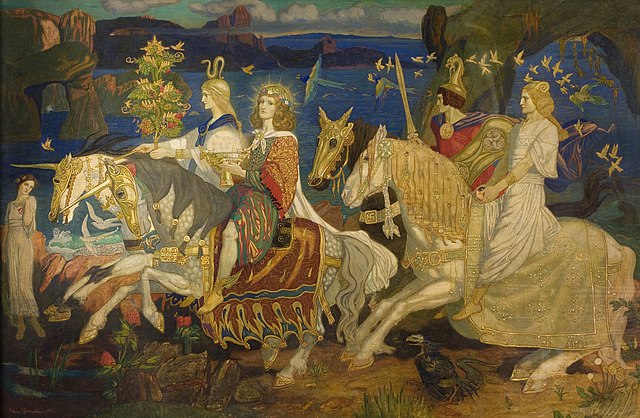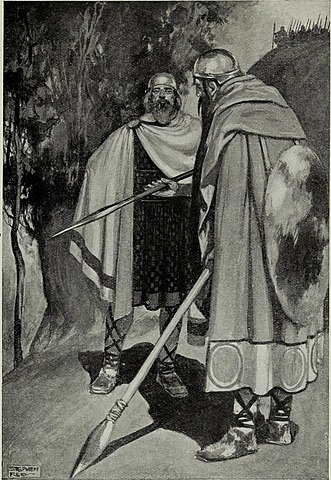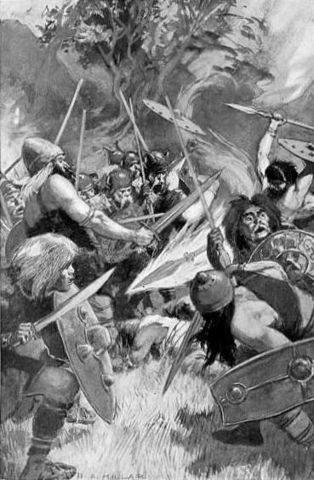The First Battle of Magh Tuireadh
Have you ever wondered how the mystical race known as the Tuatha Dé Danann came to rule Ireland? Early Irish mythology explains this through a series of battles and legendary deeds, chief among them being the First Battle of Magh Tuireadh. Today, let’s explore who fought in this battle, why it began, and how its outcome shaped the course of Irish myth.
Table of Contents
Meet the Kings

Nuada Airgetlám (Nuada of the Silver Arm)
Nuada was the king of the Tuatha Dé Danann when they first arrived on Irish shores. He was famed for his strong leadership skills and prowess in battle. His name—”Airgetlám,” meaning “Silver Arm”—comes from a significant injury he received during the First Battle of Magh Tuireadh.
Eochaid mac Eirc
Leading the other side was Eochaid mac Eirc, king of the Fir Bolg. When the Tuatha Dé Danann landed in Ireland, Eochaid was determined to protect his people’s claim to the land. Under his rule, the Fir Bolg had settled comfortably in Ireland and were not eager to share it.
The Parley: Bres and Sreng

Tuatha Dé Danann Champion: Bres
Representing the Tuatha Dé Danann in negotiations (in some accounts) was Bres, a champion of his people. Note that “Bres mac Elathan” is a name often found later in the myths. Still, here, he primarily appears as a skilled warrior sent to speak on behalf of the Tuatha.
Fir Bolg Champion: Sreng
On the Fir Bolg side was Sreng, a formidable champion known for his bravery and uncompromising nature. Sreng’s weapon of choice was a large, broad-headed spear, symbolising the direct strength of the Fir Bolg.
Their Meeting
Bres and Sreng compared their weapons and talents, each taking measure of the other’s abilities. The Tuatha Dé Danann spear was more refined and well-crafted than Sreng’s heavier, more straightforward weapon. Despite this initial display of mutual respect, the negotiations failed. The Tuatha Dé Danann wanted to share Ireland—effectively dividing the land—. In contrast, the Fir Bolg refused to relinquish territory they had only recently come to rule.
The Battle Unfolds

Outbreak of War
With no peaceful agreement in sight, both sides prepared for battle on the plains of Magh Tuireadh. Fierce skirmishes broke out as the Tuatha Dé Danann, armed with martial prowess and mystical knowledge, clashed with the determined Fir Bolg warriors.
Key Moments
- Nuada’s Injury: A pivotal moment in the conflict was when Sreng struck off Nuada’s arm in combat. In the customs of the Tuatha Dé Danann, a king who was no longer physically whole could not continue to reign, so this injury had far-reaching consequences.
- Magic and Skill: The Tuatha Dé Danann reportedly used their knowledge of magic and advanced craftsmanship to gain an advantage. Even so, the battle was hard-fought on both sides.
Outcome
Ultimately, the Tuatha Dé Danann prevailed. King Eochaid mac Eirc of the Fir Bolg was either killed in the fighting or forced to flee, depending on which version of the story you read. Though victorious, the Tuatha Dé Danann did not merely drive the Fir Bolg out. They had other plans.
The Agreement
Even in victory, the Tuatha Dé Danann showed a measure of respect to their opponents. Instead of banishing the Fir Bolg entirely, they allowed them to remain in Ireland. One of the most common myths states that the Fir Bolg were granted the province of Connacht as their domain.
This settlement stood as an early example of coexistence in Irish mythology. The Tuatha Dé Danann, though triumphant, recognised the courage and honour of the Fir Bolg and saw fit to preserve their presence on the island.
Aftermath and Legacy
Nuada’s Lost Arm
The aftermath was particularly significant for Nuada, king of the Tuatha Dé Danann. According to his people’s customs, he lost the right to rule by losing an arm. This development set off a chain of events: Bres (in another telling, Bres mac Elathan, often said to have Fomorian heritage) took the throne, leading to a different style of governance—one that eventually sparked the Second Battle of Magh Tuireadh.
Foreshadowing Future Conflicts
With the Fir Bolg subdued, the Tuatha Dé Danann now faced another threat: the Fomorians. These events served as the foundation for the Second Battle of Magh Tuireadh, which would test the Tuatha Dé Danann’s might and unity in an even more dramatic clash.
Cultural Significance
From a mythological standpoint, the First Battle of Magh Tuireadh sets the tone for how Irish legends depict sovereignty, land rights, and the notion of worthiness in leadership. It also cements the importance of physical wholeness for kingship within the Tuatha Dé Danann—an idea that would be tested and explored repeatedly in later tales.
Conclusion
In Irish mythology, the First Battle of Magh Tuireadh marks the Tuatha Dé Danann’s rise to power and highlights the complexities of claiming sovereignty. The battle demonstrates their military skill, magical abilities, and willingness to coexist with those they defeated. Nuada’s injury and subsequent loss of the throne underline the strict cultural codes of the Tuatha Dé Danann, paving the way for the next major conflict.
Understanding this mythic clash—its major players, pivotal moments, and lasting outcomes—gives us insight into the core values and storytelling traditions that have shaped Irish culture and identity for centuries. If you’re intrigued by tales of ancient warriors and legendary battles, delve further into the Mythological Cycle of Irish literature to discover more tales of magic, kingship, and fated destinies.
References:
MacKillop, James. A Dictionary of Celtic Mythology. Oxford University Press, 2004
Rolleston, T.W. Myths and Legends of the Celtic Race. 2011.
Further Reading and Exploration:
- Translations of the Táin Bó Cúailnge
- The Story of Ireland by Neil Hegarty
- Early Irish Myths and Sagas by Jeffrey Gantz
- A New History of Ireland: Prehistoric and Early Ireland, edited by Dáibhí Ó Cróinín
- The Knighting of Cú Chulainn
- Birth of Cú Chulainn
